[front cover]
| NO. I. OF PART V.] |
|
[PRICE 8s. |
NOTICE.
[ONE MORE NUMBER WILL COMPLETE THIS WORK.]
——————————————
THE
ZOOLOGY
OF
THE VOYAGE OF H.M.S. BEAGLE,
UNDER THE COMMAND OF CAPTAIN FITZROY, R.N.,
DURING THE YEARS
1832 TO 1836.
——————
PUBLISHED WITH THE APPROVAL OF
THE LORDS
COMMISSIONERS OF HER MAJESTY'S TREASURY.
——————
Edited and Superintended by
CHARLES DARWIN, ESQ. M.A., F.R.S., F.G.S.
NATURALIST TO THE EXPEDITION.
——————————————————
REPTILES,
BY
THOMAS BELL, ESQ., F.R.S., F.L.S., &c.
————————————
LONDON:
PUBLISHED BY SMITH, ELDER AND CO. 65, CORNHILL.
MDCCCXLII.
| XVIII. |
|
August. |
STEWART AND MURRAY, OLD BAILEY.
[inside front cover]
[page break]
[page break]
[page 1]
REPTILES.
~~~~~~~~~~~
| TRIBUS— | EUNOTES. Bibron. |
| FAMILIA— | TROPIDURIDÆ. Mihi. |
| TROPIDOLEPIDIENS. Bibr. | |
| GENUS— | Tropidurus. ( In part. ) Weigmann. |
| PROCTOTRETUS. Bibr. |
| CHARACTER GENERICUS.— | Pori
femorales nulli. Pori
præ-anales in maribus tantum. Crista dorsalis nulla. Dentes palatini. Squamæ imbricatæ; dorsales carinatæ. |
THE genus which I take the present favourable opportunity to illustrate, formed a section or sub-genus of the genus Tropidurus, according to Weigmann, who, however, was acquainted with two species only; Pr. Chilensis and Pr. nigromaculatus. Of the varieties of the former of these, that author has made no less than three species; but these have been very properly reduced by M. Bibron to one only. The last-named excellent erpetologist described several additional species, which had been brought from Chile, by M. D'Orbigny, and others; and I received, some years since, from Capt. King, three or four species which were found by him in the same locality, in the course of his well-known survey. The number of species altogether, hitherto known, amounts to ten; to which I have now the opportunity of adding four entirely new, forming part of the interesting collection of Reptilia made by Mr. Darwin. One of them, Pr. Kingii, was already in my collection, amongst those which were given me by Capt. King. The genus, therefore, of which, but lately, two species only were known, now consists of fourteen; and it is highly probable that more may yet be obtained by more prolonged and extensive investigation in the same districts.
B
[page] 2 ZOOLOGY OF THE VOYAGE OF THE BEAGLE.
Thus of the species now described two were known to Weigmann, and described by him, namely, Chilensis, and nigromaculatus. I received from Capt. King, Chilensis, pictus, cyanogaster, Kingii, Fitzingerii, and, from other sources, Chilensis, pictus, Weigmannii. Bibron describes the whole of these, excepting Kingii, and in addition to them tenuis, pectinatus, signifer. In Mr. Darwin's collection are found all those described by Bibron, excepting signifer; and in addition Kingii now first described, and the following species never before observed, namely, Darwinii, gracilis, Bibronii.
Although the form of the whole of the species much more nearly approximates that of the Agamidæ than most others, they are far removed from that family by several important characters, which it is unnecessary here to detail.
PROCTOTRETUS CHILENSIS.
PLATE I.—FIG. 1.
Auribus margine anteriore dentato; collo non plicato; squamis dorsi magnis, rhombeis; acutè carinatis; serie unicâ squamarum supralabialium.
Calotes Chilensis, Less. et Garn. Voy. de la Coquille, Zool. Rep. t. i. f. 2.
Tropidurus Chilensis, Weigm. Act. Acad. Cæs. Leop. Carol. Nat. cur. xvii. pp. 233, 268.
Proctotretus Chilensis, Bibr. Hist. Nat. des Rep. IV. p. 269.
Sun. Tropidurus nitidus, Weigm. l. c. p. 234, t. xvii. f. 2.
Var. Tr. olivaceus, Ib. l. c. p. 268.
Habitat, Guasco in Northern Chile.
DESCRIPTION.—Head short and broad, rostrum rounded, obtuse. Scales of the head large, and slightly raised, separated by distinct grooves. Superciliary ridge strongly marked, forming a distinct carina, composed of five or six narrow, elongated, obliquely imbricated scales. Nostrils large, nearly round. A single series of narrow scales between those of the upper lip and the orbit. Scales of the temples imbricated, rhomboidal and carinated. The opening of the ear oval, rather large, furnished anteriorly with three or four projecting scales, of which the upper one is the largest. The neck is short, robust and round, and without any lateral fold; in which it differs from every other species of the genus. The trunk is thick, rounded on the back and sides, flattened beneath, diminishing toward either extremity. The tail is ordinarily almost twice as long as the body, thick at its origin, and tapering regularly to the extremity, nearly round, excepting near the base, where it is slightly quadrilateral. The anterior feet when placed against the sides, extend backwards little more than mid-way between the shoulder and the groin; the posterior ones, stretched forward, reach the arm-pit.
The scales of the whole upper and lateral parts of the body, tail, and limbs, are loosely imbricated, large, rhomboidal, and furnished with an elevated carina, terminating in an acute point: those of the under parts are large, smooth, and obtuse.
[page] 3 REPTILES.
This is one of the most beautiful species of the genus. The general form is robust and solid, forming a remarkable contrast with most other species of the genus. The surface is beautifully relieved by the fine, large and prominent scales, which are ranged in rows of perfect regularity, of which there are about eighteen on the back and side.
In colour and markings the individuals differ considerably; so as to have given rise to the opinion that they form three distinct species. Monsieur Bibron mentions two principal varieties, constituting the Tropidurus olivaceus and Tr. Chilensis of Weigmann. In the former, the colour is of a more or less bronzed bright green, or yellowish, according as the green or yellow colour prevails on the scales, each of which is green, with a border of yellow on each side: this border, according to M. Bibron, in some individuals of a blood-red colour. In some, especially in young individuals, there are several waved bands running transversely across the back.
In the second variety, says M. Bibron, the upper parts are either of an olive colour, with a golden glance in certain lights, or fulvous, with more or less of a yellow tint; and these have always four brown bands running the length of the body, appearing as if formed of a series of large spots united together. "The temples are marked with a black line, which extends from the posterior angle of the eye to the ear; another divides behind the occiput into two branches, which pass to the neck there to join the dorsal bands." There are other variations of colour, but scarcely deserving to be considered as constituting permanent or fixed varieties; the largest and finest specimen I have seen, which I received from Chile, is almost uniformly of a fine metallic green, without any markings.
| DIMENSIONS. | |||
| Inches. | Lines. | ||
| Length | of the head........................ | 0 | 9 |
| of the body ..................... | 3 | 5 | |
| of the tail ........................ | 6 | 0 | |
| ———————— |
|||
| Total length...... | 10 | 4 | |
| Length | of anterior extremity............ | 2 | 0 |
| of posterior extremity ......... | 1 | 2 | |
This species would appear to be very common in Chile, from the numerous specimens from that country in the museum in Paris, which were brought by M. Gay, and by M. D'Orbigny. I have also received specimens from Capt. King. I find only one or two specimens in Mr. Darwin's collection, which he found at Guasco in Chile.
[page] 4 ZOOLOGY OF THE VOYAGE OF THE BEAGLE.
PROCTOTRETUS GRACILIS. N.S.
PLATE I.—FIG. 2.
Corpore gracili: capitis squamis lævibus, non imbricatis: aurium margine anteriore minutè bi-tridentato: collo vix plicato, squamis imbricatis: serie unicâ squamarun supralabialium: femorum facie posteriore omninò granulosâ.
Habitat, Port Desire, Patagonia. Mr. Darwin, MS.
DESCRIPTION.—This new species is more slender and graceful in its general form than any other of the genus, not excepting Pr. tenuis, which in its general proportions it considerably resembles. The head is rather short, the anterior portion including the eyes being nearly an equilateral triangle. The muzzle is rounded. The scales of the head flat, rather large, consisting behind the nose of three series of 2, 3, 3, and 2, mostly hexagons. The nostrils are small and perfectly round, the superciliary ridge is very slightly marked; there is but a single row of small linear scales between the labial and suborbitar. The ear is of moderate size, the anterior margin having two or three small projecting scales. The scales on the temples are imbricated and smooth; those of the sides of the neck also imbricated but very small. The neck is almost wholly without a fold, having merely a slight loose elevation of the skin. The scales of the back are small, rhomboidal, flat, the carina low, and not pointed at the extremity. They consist of about ten rows on each side of the median line. Those of the sides and belly are wholly without any notch on the free margin. The scales around the axillæ, and those of the posterior face of the thighs are granular. The tail is of considerable length, being more than twice the length of the head and body. The limbs are remarkably long; the anterior, when pressed against the side, reaching to the setting on of the thigh, and the posterior reaching forwards nearly to the ear. The general colour of the upper parts is greyish brown, with a yellow longitudinal fascia extending on each side from the upper edge of the orbit to some distance along the tail—and another from beneath the eye to the thigh. The middle of the back is lighter than the sides—beneath the second lateral line the colour fades, and on the belly it is pale buff or light yellow. The sides are dotted with black; and there are some dark waved lines and dots beneath the lower jaw.
This species is at once distinguished from every other by the fold of the neck being scarcely cognizable. It is however not so absolutely wanting as in Pr. Chilensis.
| DIMENSIONS. | |||
| Inches. | Lines. | ||
| Length | of the head........................ | 0 | 5 |
| of the body ..................... | 1 | 4 | |
| of the tail ........................ | 3 | 8 | |
| ———————— |
|||
| Total length...... | 5 |
7 | |
| Length | of anterior extremity............ | 0 | 7 |
| of posterior extremity ......... | 1 | 1 | |
A single individual of this species was taken by Mr. Darwin at Port Desire.
5
[page] 5 REPTILES.
PROCTOTRETUS PICTUS.
PLATE II.—FIG. 1, 2.
Capite squamis parvis, lævibus, non imbricatis; aurium margine anteriore granuloso; serie unicâ squamarum supralabialium; squamis temporum subcarinatis, imbricatis; collo ad latera granuloso; squamis dorsalibus parvis, rhombeis, carinâ humili, posticè obtusâ; facie posteriore femorum omninò granulosâ.
Proctotretus pictus, Bibr. l. c. p. 276.
Habitat, Chile.
DESCRIPTION.—This species is moderately slender in its general form, but more fusiform than Pr. tenuis, which it much resembles in many of its characters. The head, which is rather short, and with the snout rounded, is covered with numerous small flat plates which vary exceedingly in their form and arrangement. The upper surface of the head is flattened, and the superciliary ridges distinctly marked. The temples are covered with small flat scales, which are slightly imbricated and carinated. The sides of the neck are granulated; and the anterior margin of the auditory cavity has small simple granulations. The scales of the back are distinguished from those of many other species by the flatness of the carina which is also obtuse posteriorly; they are small and closely imbricated. Those of the sides are almost without any carina, and those of the belly and throat small and very smooth, and the whole of them entire. The upper parts of the limbs are covered with scales similar to those of the back, but smaller. Those of the under part of the fore arm are similar, but beneath the thighs they are smooth and on the posterior part of the thighs they are wholly granular. The tail is furnished with quadrilateral carinated scales disposed in whorls. The margin of the cloaca has from two to four pores.
The colour of this species varies greatly. Bibron has enumerated three principal varieties, of which I have several specimens, which were brought home and presented to me by Capt. King, who obtained them during his survey of the coast of South America. These varieties, however, occasionally run into each other.
Var. A. General colour of the upper part bronzed or coppery, having a green longitudinal line on each side of the back, at the inner margin of which is a series of very distinct black dots. The sides of the neck and body are of a similar colour to the back, with indistinct black spots; beneath this part the ground colour becomes blue with black dots. The throat is blackish, and the inferior surface generally is very pale bluish green.
Var. B. This variety is described by M. Bibron as of a brown colour more or less dotted with yellow, and having a line of that colour along each side of the back, extending from the posterior angle of the eye to the base of the tail, and having on each side a series of angular black spots. Some of these spots on the upper part of the flanks, become dilated, so as to form a sort of vertical or transverse waved bands, with yellowish margins. On the neck there are small black lines, and the upper part of the head is brown with blackish spots. The upper surface of the legs and of the tail is brown with transverse bands composed of black dots. The
[page] 6 ZOOLOGY OF THE VOYAGE OF THE BEAGLE.
whole under surface is of a whitish colour, sometimes having a slight tint of orange towards the posterior parts, marbled with black.
Var. C. In this variety the general colour is dark brown, and the yellow or green longitudinal lines which characterize the former varieties are but slightly marked; but the black spots unite and form irregular transverse bands.
| DIMENSIONS. | |||
| Inches. | Lines. | ||
| Length | of the head........................ | 0 | 6 |
| of the body ..................... | 1 | 8 | |
| of the tail ........................ | 4 | 6 | |
| ———————— |
|||
| 7 |
0 |
||
This specimen very much resembles in its more tangible characters, the Pr. tenuis; from which, however, it differs totally in the colouring, and in some measure also in the general form, which is more thick and robust.
Found in Chile by M. Gay, from whence I also received specimens from Capt. King, and other sources.— "Valparaiso." Mr. Darwin.
PROCTOTRETUS BIBRONII. N.S.
PLATE III.—FIG. 1.
Capite squamis lævibus, subconvexis; auribus ovalibus, margine anteriore unidentato; squamis temporum collique rotundatis lævibus imbricatis; colli minimis; serie unicâ squamarum supralabialium; squamis dorsi rhomboideis, carinatis, posticè acuminatis; abdominis squamis omnibus integris; femorum facie posteriori omnino granulosâ.
Habitat, Port Desire. Mr. Darwin.
DESCRIPTION.—General form resembling that of Pr. pictus and cyanogaster. Head moderately short, obtuse, covered with rather large slightly convex scales; a single row of scales between the labial and the orbitar. The anterior margin of the ear has a single tooth. The temples and the sides of the neck are covered with imbricated scales, which have no carina—those of the neck, especially those on the fold of the skin are smaller and more raised than the others. The scales of the back are rather large, rhomboidal, with a distinct carina, terminating in a point. Those of the abdomen and sides are all of them entire at the margin. The posterior surface of the thighs is wholly granular.
The only specimen obtained being a female, the number of pre-anal pores is not known.
The general colour of this species is brownish grey; a black longitudinal line runs down the middle of the back and tail. There are two series of black spots on each side, and a
[page] 7 REPTILES.
small interrupted fascia of the same colour extends from the shoulder to the thigh. The belly is of an uniform dirty white.
This species approaches considerably to Pr. cyanogaster in general form and habit, and in many of its characters; but it may be at once distinguished from it not only by its colouring, but by the absence of even the slightest appearance of a carina on any of the scales of the temples or of the sides of the neck.
| DIMENSIONS. | |||
| Inches. | Lines. | ||
| Length | of the head........................ | 0 | 6 |
| of the body ..................... | 1 | 6 | |
| of the tail ........................ | 3 | 4 | |
| ———————— |
|||
| Total length...... | 5 |
6 | |
| Length | of anterior extremity............ | 0 | 7 |
| of posterior extremity ......... | 1 | 1 | |
Found by Mr. Darwin at Port Desire, in Patagonia.
PROCTOTRETUS TENUIS.
PLATE III.—FIG. 2.
Capite squamis lævibus, non imbricatis; auribus magnis, margine anteriore sub-tuberculato; serie unicâ squamarum supralabialium; temporibus squamis rotundatis, imbricatis; collo granuloso; squamis dorsi parvis, obtusis, carinis minimis; squamis lateralibus exiguis, non imbricatis; facie posteriore femorum omninò granulosâ.
Proctotretus tenuis, Bibr. l. c. p. 279.
DESCRIPTION.—General form slender: head rather short and obtuse, covered with flattened smooth scales; anterior margin of the ears with one or more slight tubercles; temples covered with rounded imbricated scales, some of which are slightly carinated; sides of the neck, and above the shoulders granular; scales of the back small, slightly carinated, obtuse; those of the sides very small, very little imbricated; those of the belly small and smooth. The posterior surface of the thighs has no patch of imbricated scales, but is wholly granular.
The colour of the two specimens brought home by Mr. Darwin is so much obliterated, that I am obliged to have recourse to the account given by Bibron of the colour and markings of this species: — "Les deux sexes du Proctotréte svelte n'ont pas le même mode de coloration. Ni l'un ni l'autre ne portent, de chaque côté du dos, une bande longitudinale verte ou jaunâtre comme cela s'observe dans l'espèce précédente, ( Pr. pictus. )
"Le mâle a le dessus de la tête nuancé de brun et de fauve, ou bien ponctué de jaune et de noirâtre. La région cervicale est, ainsi que le dos, vermiculée de noir sur un fond brun,
[page] 8 ZOOLOGY OF THE VOYAGE OF THE BEAGLE.
qui est lui-même semé de taches, soit bleuâtres, soit verdâtres, on ardoisées; quelquefois même on en remarque de jaunâtres. Presque tous les individus ont les côtés du cou marqués chaqun d'une raie noire qui s'étend depuis le haut de l'oreille jusqu'a l'épaule. Les membres et la queue sont coupés en travers par des bandes onduleuses noirâtres, dont les intervalles se trouvent remplis par de taches, les unes bleuâtres, les autres de la couleur du cuivre rouge, la gorge tantot est jaune, tantot d'un beau vert métallique. Souvent elle est, de même que les autres régions inferieures de l'animal, vermiculée de gris-brun pâle sur un fond blanchâtres, glacé de violet.
"La femelle a toutes ses parties supérieures peintes d'un gris-brun fauve. Son cou et son dos portent deux séries parallèle de demi-cercles noirs, ayant leur bord convexe tourné de coté de la tête, et leur bord concave liseré de blanchâtre, ou bien d'une teinte plus claire que celle du fond de la couleur du dos. La région moyenne de celuici est quelquefois ponctuée de noir, ou tachetée de blanchâtre. Des lignes noires onduleuses traversent le dessus de la queue dont le dessous est souvent cuivreux. Les régions inférieures sont blanchâtres on bien colorées de la même manière que celles des individus mâles."
Mr. Darwin's only observation on the colour of this species is, that it is "brownish black with transverse black bands."
| DIMENSIONS. | |||
| Inches. | Lines. | ||
| Length | of the head........................ | 0 | 5 |
| of the body ..................... | 1 | 6 | |
| of the tail ........................ | 2 | 1 | |
| ———————— |
|||
| Total length...... | 4 |
2 | |
| Length | of anterior extremity............ | 0 | 8 |
| of posterior extremity ......... | 1 | 3 | |
Found at Valparaiso, and at Concepcion, in Chile.
PROCTOTRETUS SIGNIFER.
PLATE IV.—FIG. 1.
Capite brevi, obtuso, depresso, squamis lævibus planis; aurium margine anteriore bi-tuberculato; squamis temporum imbricatis; colli granulatis; serie unicâ squamarum supralabialium; squamis dorsi laxis imbricatis, vix carinatis; facie posteriore femorum omninò granulosa. Dorso flavescenti-griseo, signis nigris, in seriebus quatuor longitudinalibus dispositis.
Proctotretus signifer, Bibr. l. c. p. 288.
Head short, depressed, somewhat abruptly deflexed from the vertex—the scales flat, those of the supra-orbital arch being numerous, and less regular than in most other species. Between
[page] 9 REPTILES.
the labial scales, and the long infra-orbital plate is a single series of rounded scales.* The scales of the temples are rather large, somewhat rounded, slightly imbricated, and a few of the posterior ones having the vestige of an obtuse carina. The ear is rather small, the anterior margin having two slightly prominent scales towards the lower part.
The body is depressed; the tail moderately long, thick and slightly four-sided at the base, becoming much smaller and round towards the middle. The scales of the sides of the neck are small and granular; those of the upper parts of the body small, rhomboidal, rounded posteriorly, loose, much imbricated, and with an extremely low and inconspicuous carina. They are arranged in about twenty-two longitudinal series. Those of the sides are larger and quite smooth. The scales of the whole under part of the throat and belly are rhomboidal, smooth and much imbricated; a very few towards the sides of the abdomen are slightly notched at the apex. The under surface of the anterior and the hinder surface of the posterior extremities are covered with very fine granular scales; those of the upper surface of the members being rhomboidal, smooth, but slightly carinated and obtuse. The tail is covered with small rhomboidal scales which are considerably imbricated and distinctly carinated. The scales of the upper surface of the toes are smooth; those on their sides uni-carinated, and those beneath tri-carinated and broad.
The general colour of the upper parts is a yellowish grey, with black markings, which have somewhat the character, as Mons. Bibron observes, of Arabic letters. On the neck and back these markings are disposed in four longitudinal series; and there are small linear markings on the upper part of the shoulders and thighs. The tail is similarly marked, the under parts are whitish, with brown lines and spots.
| DIMENSIONS. | |||
| Inches. | Lines. | ||
| Length | of the head ........................ | 0 | 6 |
| of the body ..................... | 1 | 5 | |
| of the tail ........................ | 3 | 0 | |
| ———————— |
|||
| Total length...... | 5 |
1 | |
| Length | of anterior extremity............ | 0 | 8 |
| of posterior extremity ......... | 1 | 2 | |
This species is not found amongst the reptiles obtained by Mr. Darwin, but as it has never been figured, it appeared very desirable that this opportunity should not be lost. I am indebted to the great kindness of my friend M. Bibron for the loan of the only specimen which I have seen, and from which the accompanying figure is taken. It formed part of the zoological collections obtained by Mons. D'Orbigny for the French Museum.
* Mons. Bibron states that there are two series, but on examining his specimen I find a single series only.
C
[page] 10 ZOOLOGY OF THE VOYAGE OF THE BEAGLE.
PROCTOTRETUS NIGROMACULATUS.
PLATE IV.—FIG. 2.
Capite brevi, squamis neque imbricatis nec carinatis, tecto; auribus margine anteriore tridentato; serie unicâ squamarum supralabialium; squamis temporum magnis, rotundatis, imbricatis; colli ( et præcipuè plicæ ) crassis, elevatis; facie posteriore femorum omninò granulosâ; squamis nonnullis ad latera abdominis gulæque emarginatis; maculâ transversè oblongâ, nigrâ, supra regionem scapularem.
Tropidurus (Leiolæmus) nigromaculatus, Weigm. Act. Acad. Cæs. Nat. cur. xvii. p. 229.
Proctotretus nigromaculatus, Bibr. l. c. p. 281.
Habitat, Coquimbo, Chile.
DESCRIPTION.—Head short, the muzzle rounded, rather obtuse; scales of the upper part of the head somewhat convex, smooth; a single line of scales between the labial and orbitar; ears rather large, the anterior margin having three rather prominent scales, the middle one being the largest. Temporal scales somewhat large, smooth, rounded, and imbricated, those towards the upper part slightly carinated; those of the sides of the neck thick and elevated, those on the fold being rather acutely prominent; scales of the back carinated, the carina terminating in an acute point; a few of the scales at the sides of the abdomen and throat notched; the remainder of the scales of the under parts rhomboidal. The scales about the axilla and around the base of the shoulder are granular and very small, as are those of the posterior surface of the thighs, on which part there are no imbricated scales as in Tr. Fitzingerii. The tail is round, excepting at the base where it is slightly flattened; it is moderately long and slender. The anterior extremity placed against the side does not reach to the thigh; the posterior similarly placed reaches to the shoulder. The colour of this species is yellowish grey above, with a yellowish longitudinal line on each side the back, and two rows of black spots each margined with yellow behind. There is a large and distinct oblong black mark on the region of the scapula, from which circumstance the species takes its name. On the posterior surface of the thighs, towards the upper part, are three or four black dots placed in a line. The under surface is yellowish white with dark grey dots and lines under the chin and throat.
| DIMENSIONS. | |||
| Inches. | Lines. | ||
| Length | of the head........................ | 0 | 5 |
| of the body ..................... | 1 | 5 | |
| of the tail ........................ | 2 | 8 | |
| ———————— |
|||
| Total length...... | 4 |
8 | |
| Length | of anterior extremity............ | 0 | 8 |
| of posterior extremity ......... | 1 | 2 | |
This species was first described by Weigmann, and subsequently by M. Bibron, from specimens obtained by Gaudichaud from Coquimbo, at which place the single specimen brought home by Mr. Darwin was also obtained.
[page] 11 REPTILES.
PROCTOTRETUS FITZINGERII.
PLATE V.—FIG. 1.
Capite squamis lævibus, non imbricatis; margine anteriore aurium granuloso; squamis supralabialibus ovalibus, in serie unicâ dispositis; squamis dorsalibus parum carinatis, postice obtusis. Facie posteriore femorum præcipuè granulosâ sed portione, caudam versus, squamis majoribus, rhomboideis imbricatis tectâ.
Proctotretus Fitzingerii, Bibr. l. c. p. 286.
Habitat, Patagonia.
DESCRIPTION.—General form thick and robust, the head short being nearly as broad as it is long. The muzzle slightly rounded. Scales of the head flat, small and numerous. Two scales only behind the rostral and between those which are pierced by the nostrils. Those over the nose and around the occipital scales being larger and more regularly arranged than the others. The ear is large, oval, the anterior margin having, towards the upper part, about three small, oval, granular, very slightly projecting scales. Temples covered with small, rounded or slightly hexagonal scales, which are scarcely imbricated. A single range of rather broad oval scales between the orbit and the upper lip. Scales of the sides of the neck, and above and behind the shoulder small, granular. The trunk thick; scales of the back very small, imbricated, very slightly carinated, and not pointed behind; those of the under parts smooth and rhomboidal. The legs are short and robust. The anterior pair, placed against the side do not extend backwards more than halfway to the thigh. The posterior pair do not quite reach the arms. The posterior face of the thighs is covered with granular scales, excepting a large patch near the groin rising to near the upper surface of the thigh, which are imbricated and rhomboidal, similar to those of the inferior surface of the thigh. The scales of the upper part of the toes are smooth, those beneath have one or two slight carinæ.
This species varies very much in colour; three or four tolerably distinct varieties may be noticed, but they often pass more or less into each other. As I have only one of these varieties in my possession, I quote the following description from Mons. Bibron's account of the specimens in the French Museum.
Var. A. Les parties supérieures sont grises, ou bien d'un brun marron plus ou moins clair. Il règne au long du cou et du dos quatre series de taches noires, bordées de blanc en arrière. La queue et les membres offrent des bandes transversales anguleuse, d'un teint marron noirâtre, alternant avec des bandes semblables mais de couleur blanche. Les régions inférieures aussi sont blanches, excepté la gorge, qui est parcourue par des raies confluentes brunes. D'autres raies d'un brun marron sont imprimées verticalement, sur les lèvres.
Var. B. Cette variété se distingue de la precedente, en ce que le dessus de ses membres est ponctué de noirâtre, et que les quatre séries de taches qui ornent le dos de la première variété sont appliquées ici sur un fond fauve jaunâtre. Puis la gorge est verdâtre et le ventre noir, marbré de blanc.
[page] 12 ZOOLOGY OF THE VOYAGE OF THE BEAGLE.
Var. C. Le dessus du corps est uniformement peint d'un vert olive. Le dessus du cou, le milieu de la poitrine et celui du ventre sont d'un noir profond.
| DIMENSIONS. | |||
| Inches. | Lines. | ||
| Length | of the head........................ | 0 | 7 |
| of the body ..................... | 2 | 8 | |
| of the tail ........................ | 4 | 2 | |
| ———————— |
|||
| Total length...... | 7 |
7 | |
| Length | of anterior extremity............ | 1 | 2 |
| of posterior extremity ......... | 2 | 0 | |
This species agrees with Pr. Darwinii and Weigmannii, and in some degree with Pr. Kingii, in having a portion of the posterior face of the thighs covered with imbricated scales. This is a character, which although existing in all those which I have named, is found to obtain in very different degrees; in Tr. Weigmannii being very distinctly marked, and in Tr. Kingii very slightly so, and in some specimens scarcely notable. It is probable, that var. B., and possibly A. also, of Mons. Bibron, may be Pr. Kingii; but I have not had the opportunity of ascertaining this from the actual examination of the specimens.
Found by Mr. Darwin at Port Desire, and at Santa Cruz, in Patagonia.
PROCTOTRETUS CYANOGASTER.
PLATE V.—FIG. 2.
Squamis capitis neque imbricatis nec carinatis; temporum imbricatis, subcarinatis, margine rotundato; aurium margine anteriore simplici; squamis dorsalibus rhombeis, laxis, carinâ posticè acutâ; femorum facie posteriore omninò granulosâ; corpore suprà olivaceo, fascia utrinque longitudinali flavescenti; abdomine cœruleo.
Proctotretus cyanogaster, Bibr. l. c. p. 273.
Habitat, Valparaiso, and Valdivia, Chile.
DESCRIPTION.—It has been well observed by M. Bibron that this species offers at first sight somewhat the general aspect of the genus Algira; the acute points of the dorsal and lateral scales and the general form giving very much that appearance.
The head is of moderate size, somewhat deflexed; the scales moderate, flat and smooth; those of the temples are slightly carinated, imbricated and rounded: those of the sides of the neck small, not granular, but rhomboidal and imbricated. There is but a single series of oblong scales between the labial ones and the orbit. The margin of the ear is entire and simple; the
[page] 13 REPTILES.
scales of the back are lozenge-shaped, the carina of moderate height but prolonged into an acute point. Amongst those of the sides of the neck and belly are a few which are notched at the margin.* The scales of the posterior surface of the thigh are wholly granular.
The proportions of the limbs vary in the two sexes. In the male they are considerably longer than in the female. In the latter the posterior extremity when placed against the side extends only to the arm, in the former it reaches to the ear. The ground colour of the back is chesnut brown or greenish brown, with a bright metallic green glance in certain lights; there are two light buff longitudinal fasciæ running the whole length of the body; the under parts are of a bright metallic blue colour. Mr. Darwin states that in one specimen there were emerald spots on the sides, which did not exist in another individual. This may possibly be a sexual peculiarity.
| DIMENSIONS OF A MALE SPECIMEN. | |||
| Inches. | Lines. | ||
| Length | of the head........................ | 0 | 6 |
| of the body ..................... | 1 | 9 | |
| of the tail ........................ | 3 | 3 | |
| ———————— |
|||
| Total length...... | 5 |
8 | |
| Length | of anterior extremity............ | 1 | 0 |
| of posterior extremity ......... | 1 | 5 | |
Found by Mr. Darwin at Valparaiso, and at Valdivia; the former is a very dry rocky country, with a scanty vegetation; whereas the latter is nearly level, covered with the thickest forest, and the climate exceedingly humid.
PROCTOTRETUS KINGII, N.S.
PLATE VI.—FIG. 1, 2.
Squamis capitis neque imbricatis nec carinatis; supralabialibus in serie unicâ; aurium margine anteriore granuloso; interdum unidentata; squamis, dorsalibus carinatis, posticè acuminatis, femorum facie posteriore præcipuè granulosâ, sed portione parvâ, caudam versus, squamis parvis, rotundatis imbicratis tectâ.
Habitat, Port Desire in Patagonia.
DESCRIPTION.—General form robust and full; the head short, thick, and passing into the neck without any distinct contraction; the muzzle rounded. Scales of the head larger in proportion than in Pr. Fitzingerii. Ear large, oval, with the anterior margin granular, sometimes slightly toothed. Scales of the temples of moderate size, imbricated, smooth, somewhat raised. A single range of oval moderate-sized scales between the labial and the orbital scales on the
* This is contrary to the character given by M. Bibron, who states that the whole of these are entire.
[page] 14 ZOOLOGY OF THE VOYAGE OF THE BEAGLE.
sides of the neck, above and behind the shoulder small, granular, and some of them having a minute pore. Scales of the back of moderate size, larger than in Fitzingerii, rhomboid, having a rather prominent carina, and terminating in a distinct point. Scales of the under parts smooth and rhomboidal. The posterior surface of the thighs is for the most part granular, but a small portion near the groin is covered with larger imbricated scales; to a much smaller extent, however, than in Fitzingerii, and other species which possess this character.
The general colour of the upper part of this species is a rich dark brown, with whitish transverse bands and spots, having a black margin. I have figured in fig. 2, of Plate VI., a remarkable variety in which the bands are alternate black and white, and a broader and a narrower longitudinal fascia of a yellowish-white colour, run the whole length of the body on each side. The under parts are yellowish-white, with dark or almost black spots; under the throat bluish-gray with white spots.
| DIMENSIONS. | |||
| Inches. | Lines. | ||
| Length | of the head........................ | 0 | 8 |
| of the body ..................... | 2 | 3 | |
| of the tail ........................ | 3 | 4 | |
| ———————— |
|||
| Total length...... | 6 |
5 | |
| Length | of anterior extremity............ | 1 | 1 |
| of posterior extremity ......... | 1 | 4 | |
This species much resembles Pr. Fitzingerii in many of its characters, as well as in its size. It may, however, be at once distinguished from it by the character of the scales of the back, which in this species are very distinctly carinated, of a rather elongated form, and pointed at the extremity; whereas in the other they are shorter, smaller, the carina is very slight, almost indistinct, and the posterior extremity is obtuse.
The tail in the larger figure of our plate is deformed, having been renewed. The specimen figured at ( 2,) in the same plate, is so remarkably distinct in the colours and marking, as to lead me to suppose that it may possibly be a different species.
PROCTOTRETUS DARWINII.
PLATE VII.—FIG. 1, 2.
Corpore subdepresso; capite squamis numerosis, parvis, subelevatis, lævibus non imbricatis; aurium margine anteriore integro; temporibus colloque granulatis; serie unicâ squamarum supralabialium; facie posteriore femorum partìm granulosâ, partìm squamis imbricatis tectâ.
Habitat, Bahia Blanca, Northern Patagonia. Mr. Darwin.
[page] 15 REPTILES.
DESCRIPTION.—The general form of this new species is similar to that of Pr. Weigmannii, but less elongate and somewhat more depressed, resembling in general appearance some of the forms of the genus Sceloporus. Head covered with rather small and consequently numerous scales, slightly elevated, and separated from each other by distinct and deep lines. A single series of small scales between the labial scales and the orbit. The exterior margin of the ear is entire and even. Scales of the temple and at the sides of the neck wholly granular, the latter very small. The scales of the back are small, flat, with a very low carina, and not pointed at the posterior extremity. There are about twenty rows of dorsal scales. The posterior surface of the thighs is granulated, excepting a small patch near the tail of imbricated scales, similar to those of the inferior surface, as in Pr. Weigmannii. The tail is of moderate length, and the scales which cover it are short, depressed, and obtuse in comparison with those of several other species. The pre-anal pores, which are peculiar to the male, are about ten in number.
The general colour is gray, with two light longitudinal lines on each side, and a row of black spots along the inner margin of the dorsal ones. The under surface is nearly white, with black dots under the throat.
The anterior legs, when stretched backwards against the side, reach about two-thirds towards the thigh; and the posterior when stretched forwards, extend to the shoulder.
| DIMENSIONS. | |||
| Inches. | Lines. | ||
| Length | of the head........................ | 0 | 5 |
| of the body ..................... | 1 | 6 | |
| of the tail ........................ | 3 | 4 | |
| ———————— |
|||
| Total length...... | 5 |
5 | |
| Length | of anterior extremity............ | 0 | 8 |
| of posterior extremities ......... | 1 | 2 | |
It is at first sight extremely difficult to distinguish this species from younger individuals of Pr. Fitzingerii, from which, however, it differs in the more linear form of the supralabial scales, in the absence of imbricated scales on the lateral fold of the neck, the more entire margin of the ear. In the existence of a patch of larger imbricated scales on the posterior surface of the thighs, it resembles Pr. Weigmannii; from which, however, it may be at once distinguished by the single row of supralabial scales, the later species having a double row.
PROCTOTRETUS WEIGMANII.
PLATE VIII.—FIG. 1, 2.
Capite squamis lævibus non imbricatis tecto; auribus rotundis margine anteriore
[page] 16 ZOOLOGY OF THE VOYAGE OF THE BEAGLE.
minutè granulato. Seriebus duabas squamarum supralabialium. Femorum facie posteriore partìm granulosâ, partìm squamis minutis imbricatis tectâ.
Proctotretus Weigmannii, Bibr. l. c. p. 284.
Habitat, Northern Patagonia and La Plata.
DESCRIPTION.—Head rather short, covered with numerous slightly raised scales, not carinated nor imbricated; snout rather obtuse and slightly rounded, nostrils semicircular. Two series of very small scales between the labial scales and the orbit. Ear of moderate size, the anterior margin furnished merely with minute granular scales. Scales of the temples flat and smooth. Fold on the sides of the neck distinctly marked, anteriorly bifurcated; the remainder somewhat waved. Sides of the neck granulated scales of the whole of the upper and back parts of the body and tail of moderate size, the carina little elevated and the point but slightly prominent. The scales of the inferior parts of the neck and body are smooth, polished, and imbricated, those towards the sides of the neck minutely emarginated. The scales of the limbs resemble those of the body; those of the upper surface being carinated and those beneath smooth. The posterior face of the thighs is generally covered with granular scales, but there is on this part near the tail, a distinct patch of imbricated scales resembling those of the inferior surface of the thighs, a character by which this species may at once be distinguished from all others. The anterior extremity placed against the side reaches about two-thirds of the distance towards the groin; the posterior extremity reaches forward to the shoulder.
COLOUR.—The back and sides are brownish gray, with a yellow longitudinal band on each side of the back, separating transverse black or dark brown bands of various size and form; and there is in most on each side a smaller interrupted yellow band. The under parts generally of a yellowish white, in some individuals sparsely dotted with black. Mr. Darwin says of some individuals of this species that they have "an orange-coloured gorge, and faint stripes of blue," also "ash-grey with dark brown marks and specks of orange and blue."
| DIMENSIONS. | |||
| Inches. | Lines. | ||
| Length | of the head........................ | 0 | 5 |
| of the body ..................... | 1 | 5 | |
| of the tail ........................ | 2 | 2 | |
| ———————— |
|||
| Total length...... | 4 |
2 | |
| Length | of anterior extremity............ | 1 | 1 |
| of posterior extremity ......... | 0 | 8 | |
This species was found by Mr. Darwin at Bahia Blanca and at Rio Negro, on the northern confines of Patagonia, and at Maldonado, near the mouth of the Rio Plata.
[page break]
[page break]
[REPTILES Pl. 1.]
Plate 1.
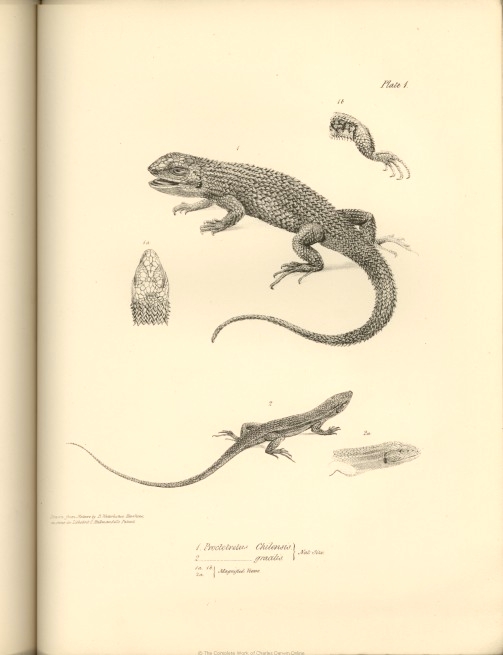
Drawn from Nature by B. Waterhouse Hawkins,
on
stone in Lithotint. C. Hallmandel's
Patent.
| 1. Proctotretus Chilensis. | ⌉ ⌋ |
Nat. Size. | ||
| 2. __________ gracilis. | ||||
| 1a.1b. | ⌉ ⌋ |
Magnified
Views. |
||
| 2a. | ||||
[page break]
[page break]
[page break]
[REPTILES Pl. 2.]
Plate 2.

Drawn from Nature by B. Waterhouse Hawkins,
on
stone in Lithotint. C. Hallmandel's
Patent.
1. 2. Proctotretus pictus. Nat: Size.
[page break]
[page break]
[page break]
[REPTILES Pl. 3.]
Plate 3.
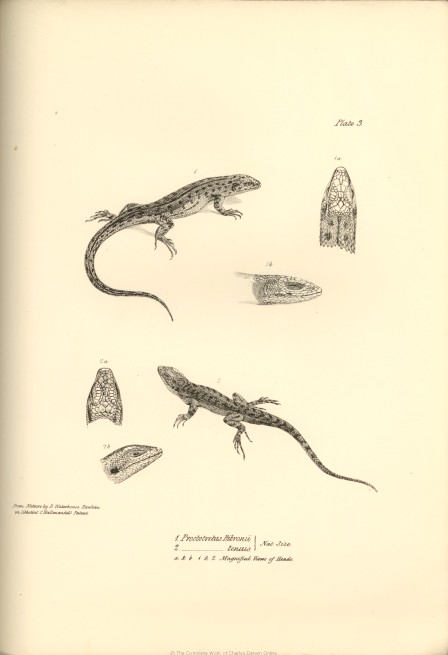
From Nature by B. Waterhouse Hawkins.
in Lithotint C. Hallmandel's
Patent.
| 1. Proctotretus Bibronii |
⌉ ⌋ |
Nat: Size. |
| 2.
__________ tenuis. |
||
| a & b. 1 & 2. Magnified Views of Heads. |
[page break]
[page break]
[page break]
[REPTILES Pl. 4.]
Plate 4.
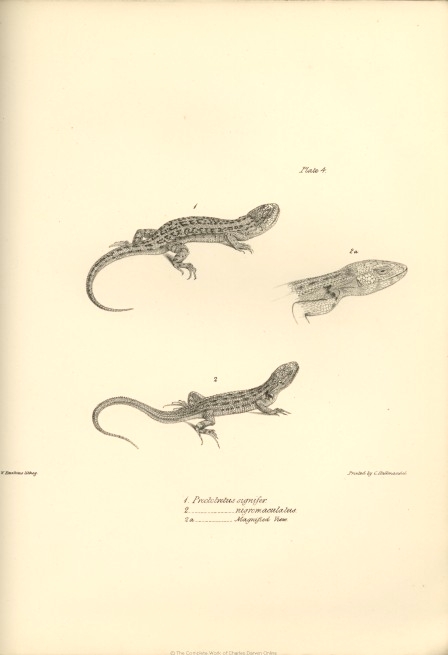
W. Hawkins lithog. Printed by C. Hallmandel.
1. Proctotretus
signifer.
2. __________ nigromaculatus.
2a. _________ Magnified View.
[page break]
[page break]
[page break]
[REPTILES Pl. 5.]
Plate 5.
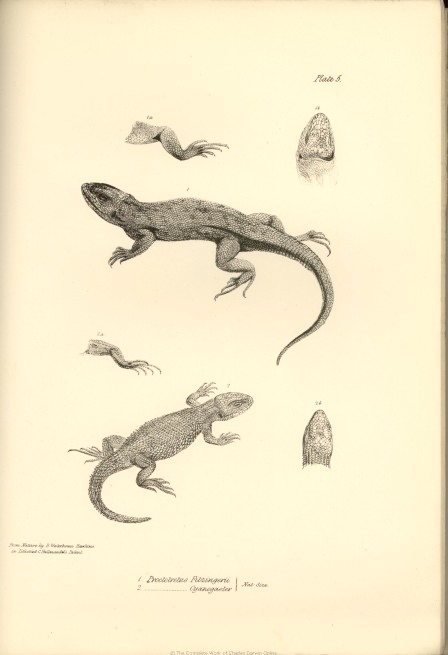
From Nature by B. Waterhouse Hawkins.
in Lithotint C. Hallmandel's
Patent.
| 1. Proctotretus
Fitzingerii. |
⌉ ⌋ |
Nat: Size. |
| 2.
__________ Cyanogaster. |
[page break]
[page break]
[page break]
[REPTILES Pl. 6.]
Plate 6.
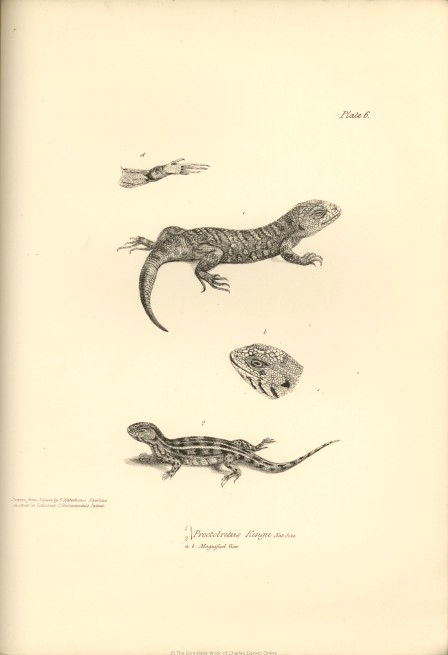
Drawn from Nature by B. Waterhouse Hawkins,
on
stone in Lithotint. C. Hallmandel's
Patent.
| 1 |
⌉ ⌋ |
Proctotretus Kingii.
Nat:
Size. |
| 2 |
||
| a. b. Magnified View. | ||
[page break]
[page break]
[page break]
[REPTILES Pl. 7.]
Plate 7.
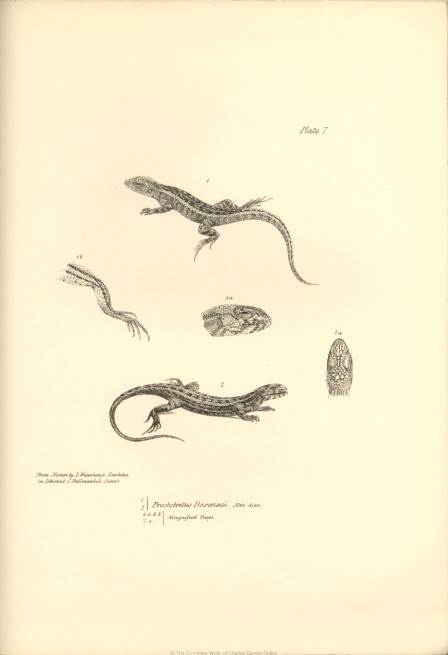
From Nature by B. Waterhouse Hawkins,
in Lithotint C. Hallmandel's
Patent.
| 1 |
⌉ ⌋ |
Proctotretus Darwinii.
Nat:
Size. |
| 2 |
||
| 1a.
& b. |
⌉ ⌋ |
Magnified Views. |
| 2 a. |
[page break]
[page break]
[page break]
[REPTILES Pl. 8.]
Plate 8.
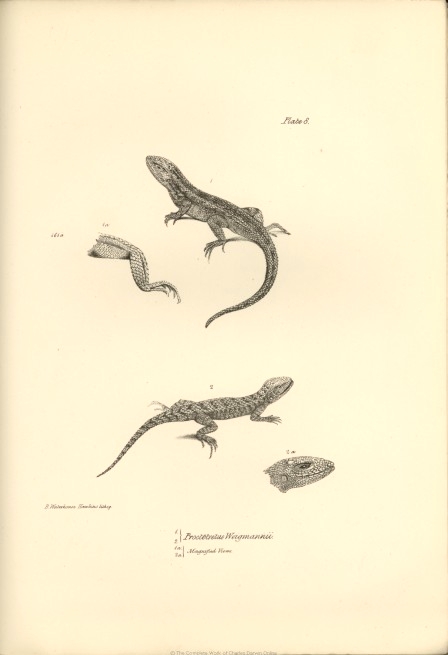
B. Waterhouse Hawkins lithog.
| 1. |
⌉ ⌋ |
Proctotretus
Weigmannii. |
| 2. |
||
| 1a. |
⌉ ⌋ |
Magnified Views. |
| 2a. |
[page break]
[page break]
[page break]
[REPTILES Pl. 9.]
Plate 9.
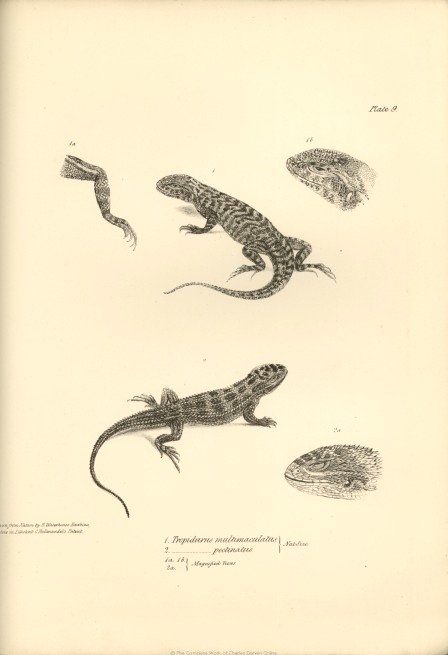
Drawn from Nature by B. Waterhouse Hawkins,
on
stone in Lithotint C. Hallmandel's
Patent.
| 1.
Tropidurus multimaculatus. |
⌉ ⌋ |
Nat: Size. | ||
| 2.
_________ pectinatus. |
||||
| 1a. 1b. | ⌉ ⌋ |
Magnified
Views. |
|
|
| 2a. | ||||
[page break]
[page break]
[page break]
[REPTILES Pl. 10.]
Plate 10.
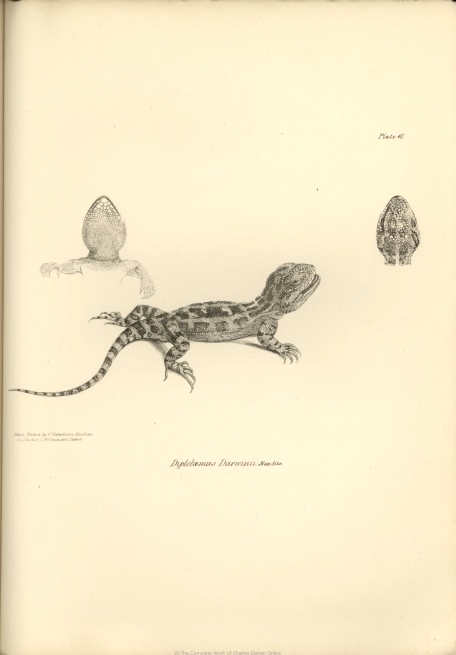
From Nature by B. Waterhouse Hawkins,
in Lithotint, C. Hallmandel's
Patent.
Diplolæmus Darwinii. Nat: Size.
[page break]
[page break]
[page break]
[inside back cover]
[back cover]
THE NUMBERS ALREADY PUBLISHED OF THIS WORK CONTAIN AS FOLLOWS.
| NOS. I.
VII. VIII. AND XIII. |
NOS. III. VI. IX. XI. AND XV. |
| FOSSIL
MAMMALIA, |
BIRDS. |
| BY
RICHARD
OWEN, ESQ. F.R.S. Professor of Anatomy and Physiology to the Royal College of Surgeons, London. WITH A GEOLOGICAL INTRODUCTION, BY CHARLES DARWIN, ESQ. M.A., F.R.S. This Division of the Work is now complete, Price £1 10s. |
BY
JOHN
GOULD,
ESQ. F.L.S. WITH A NOTICE OF THEIR HABITS AND RANGES, BY CHARLES DARWIN, ESQ. M.A., F.R.S. This Division of the Work is now complete, Price £2 15s. |
| ~~~~~~~~~~~~~~~~ | ~~~~~~~~~~~~~~~~ |
| NOS. II. IV. V. AND X. | NOS. XII. XIV. XVI. AND XVII. |
| MAMMALIA, | |
| BY
GEORGE
R. WATERHOUSE, ESQ. Curator of The Zoological Society of London, &c. This Division of the Work is now complete, Price £1. 18s. |
FISH. BY THE REV. LEONARD JENYNS, M.A., F.L.S. This Division of the Work is now complete, Price £1 14s. |
*** The whole of the Plates are
engraved
in the
highest style of Art, from Drawings taken expressly for this Work,
and most of them beautifully coloured after Nature.
——————————————
NOW PUBLISHED, WITH THE APPROVAL OF THE LORDS COMMISSIONERS OF HER MAJESTY'S TREASURY.
THE STRUCTURE AND DISTRIBUTION
OF
CORAL REEFS;
Being the First Part of the Geological Observations made during the "Voyage of the Beagle" in the years 1832 to 1836, under the command of Capt. FITZROY, R.N.
BY
CHARLES DARWIN, M.A., F.R.S., F.G.S., ETC.
NATURALIST TO THE EXPEDITION.
——————
IN ONE VOLUME DEMY OCTAVO, ILLUSTRATED WITH WOODCUTS AND MAPS. PRICE 15s.
—————————
PREPARING FOR PUBLICATION, BY THE SAME AUTHOR,
PART II.
CONTAINING
GEOLOGICAL OBSERVATIONS
ON
THE VOLCANIC ISLANDS,
Visited during the Voyage of H. M. S. Beagle.
PART III.
WILL TREAT ON THE
GEOLOGY OF SOUTH AMERICA.
——————
PUBLISHED BY SMITH, ELDER AND CO., 65, CORNHILL.
[Continued in Reptiles Part 5 No. 2]